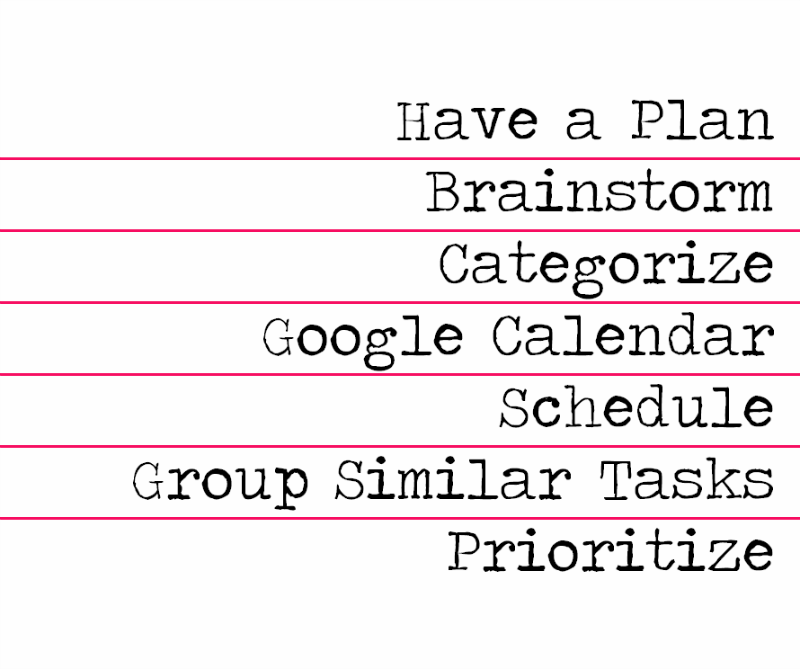blog organization.
In my experience blogging over the past two years (yes, Pretty & Fun turned two last week!), I’ve found that being and staying organized has been an essential part of being successful. I’m very task and list oriented by nature and do best when there’s a clear plan with actionable steps in place, so having any question of, “what am I going to blog about?” kills my odds of actually getting much done. I’ve shared a few glimpses into my process with photos of crazy post-it covered walls and get a lot of questions about my planning and time management, so I wanted to share a few tips and tricks that may help you with some blog organization.
- Have a Plan: “Blog” is a pretty broad term when it comes to making a to do list – there are so many components to blogging, from actual post writing to answering emails & comments and tackling your Google Reader (RIP). I’ve found that I tend to get the most done when I break this broad label down into individual tasks and stick to a set plan. Figure out what works best for your personal schedule and what your blog’s needs really are on a daily, weekly and monthly basis and come up with a plan and set schedule that allows you to get the most done in the most efficient way.
- Brainstorm: Think big! Instead of just thinking up individual post ideas, take time to sit down and brainstorm out a wide variety and large amount of topics at a time. Write down everything (even the ideas you have a feeling you’ll end up scrapping) and reread through the list, then see if any new ideas come up during review. Thinking creative is always easier once you are in that mindset. Inspiration is everywhere – write down every blog idea that crosses your mind (I use the “notes” section on my iPhone for on the go ideas)
- Categorize: When thinking through post ideas, see where the natural categories start to form. I’ve found it’s easiest to plan out weekly content calendars when I am able to categorize each post – this is helpful for adding variety to your post schedule to ensure your content has a nice mix of topics. Categorizing posts is also helpful for identifying your blog’s niche and determining if there is a set area that could be a potential opportunity to differentiate yourself.
- Google Calendar: Meet your new best friend, Google Calendar. I use Google Calendar a lot for my own personal schedule and finances so I set up a separate blog calendar under my account to plan out my content calendar, key deadlines and dates. I use color coded labels to identify sponsored posts or product reviews to easily see at a glance if I’m going overboard with sponsored content. Google Calendar also makes it easy to keep track of post ideas beyond what you have lined up for the current week – I set up a calendar event for each post idea and drag the extras over to the weekend. It’s a nice way to see what I have on the back-burner ideas-wise in case plans change and I no longer love what I had lined up.
- Schedule: Scheduling posts in advance is my savior – I’ve found that having scheduled content is what truly keeps me sane. Blogging should be an enjoyable activity, not a chore and planning ahead and scheduling posts really helps with that. If you’ve ever used “oh I have to blog” as an excuse not to go out for drinks after work or to cut out early on a night out, start planning ahead and scheduling. You’ll thank me later.
- Group Similar Tasks: I’ve found that it’s always easier to complete multiple related tasks in one sitting than try and do a variety of individual tasks in short bursts. For example, I break most blog posts down into three main tasks: writing copy, finding content/products and developing creative. When I work on posts over the weekend, I’ll knock out all similar tasks at one time, and then shift over into the next phase for each post. I’ve began scaling this all the way down to even tasks such as emails, comments or reading and commenting on other blogs and it’s helped me with getting the most possible done during the block of time I’ve dedicated for those tasks.
- Prioritize: Be realistic about your schedule, your overall workload and how much time each day you can set aside to dedicate to blogging. When things come down to the wire and you start to feel overwhelmed, prioritize your time. Think through what is on your blog-related to do list and identify what is actually time sensitive or what could wait. Ranking tasks in order of priority will help you see through the initial busy stress and make it so you have a clear, actionable plan to work with.
Have any blog organization secrets of your own to share? It’s always pretty fascinating to see “under the hood” and get a feel for everyone’s individual process and I’d love to hear more about yours!







